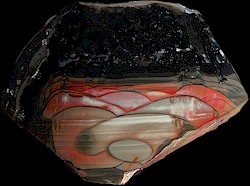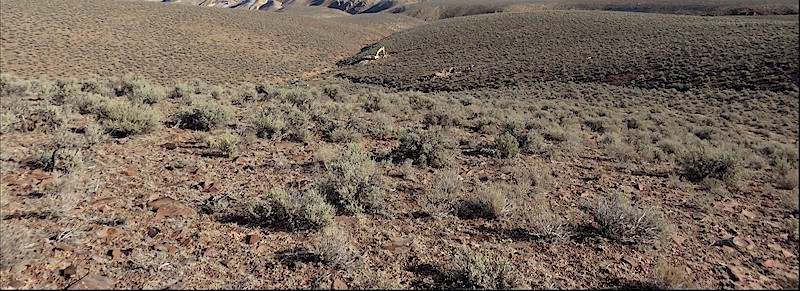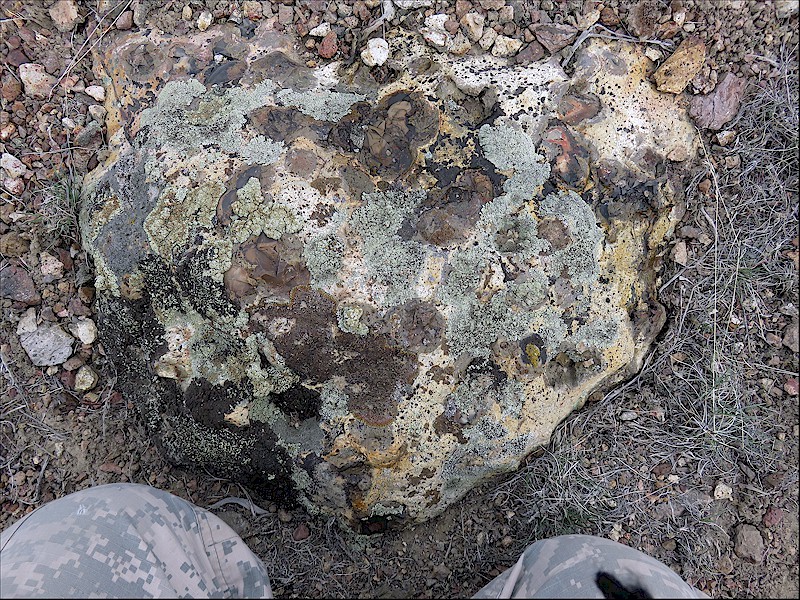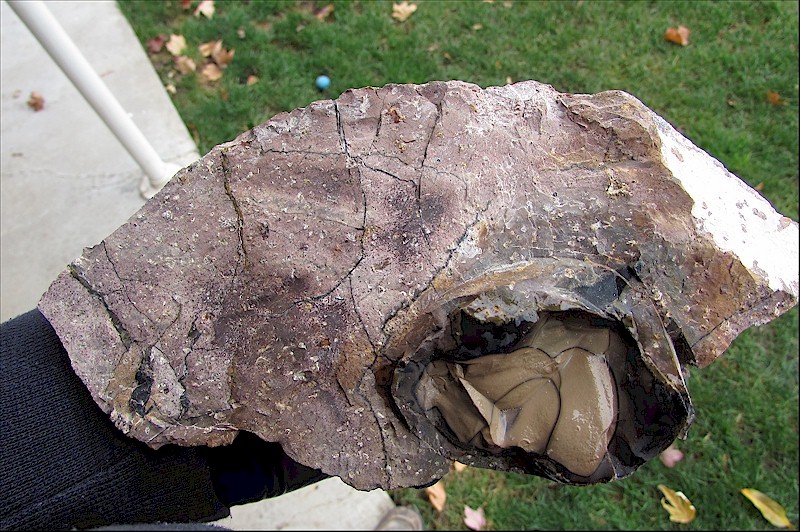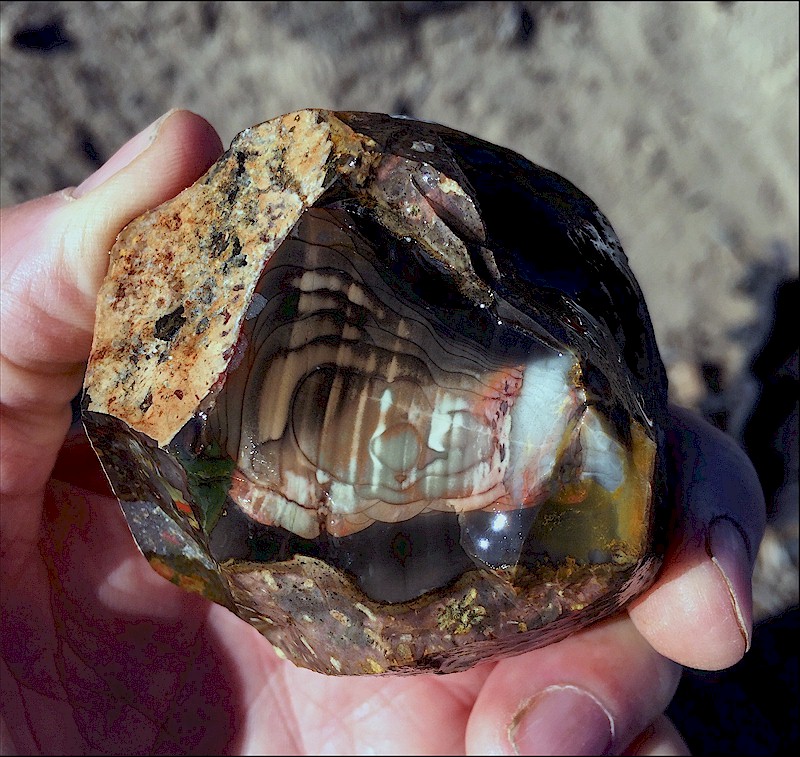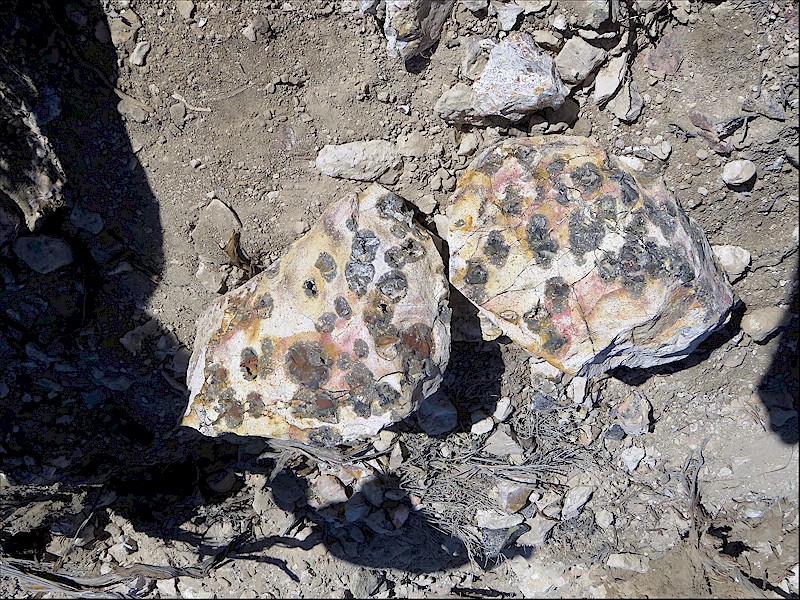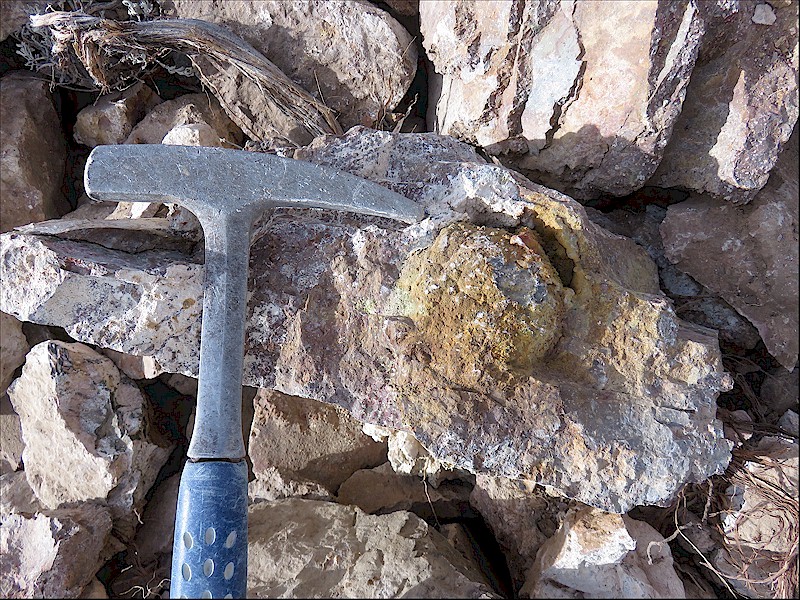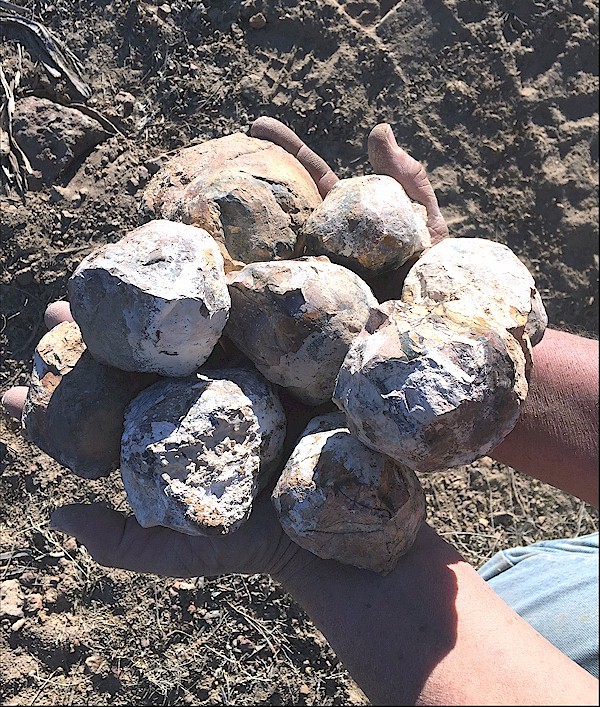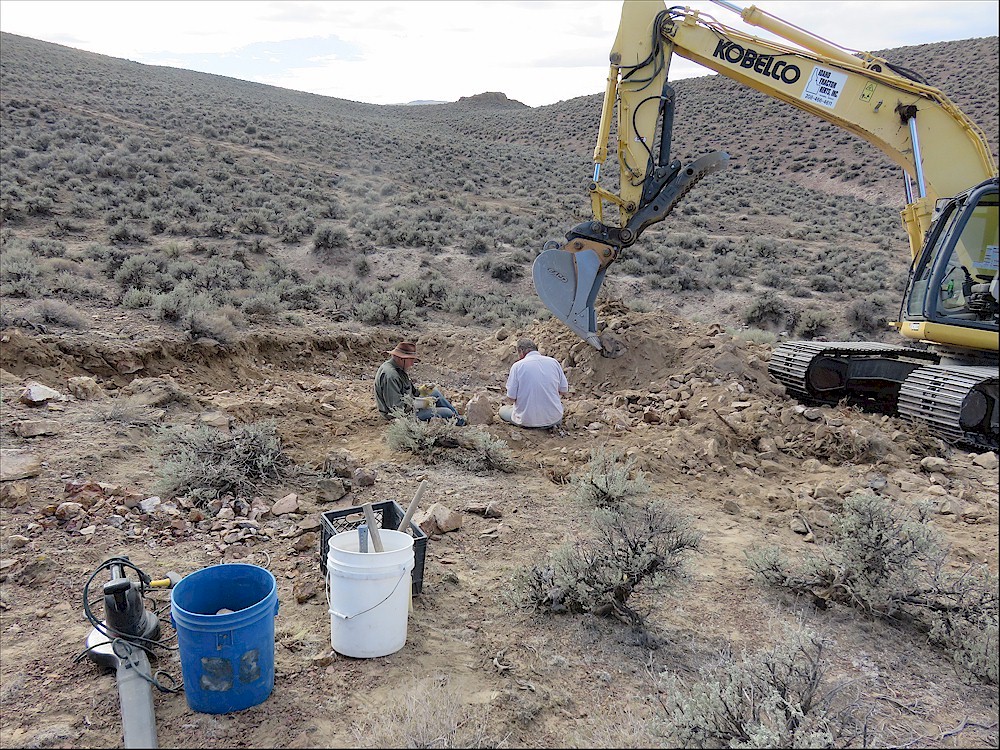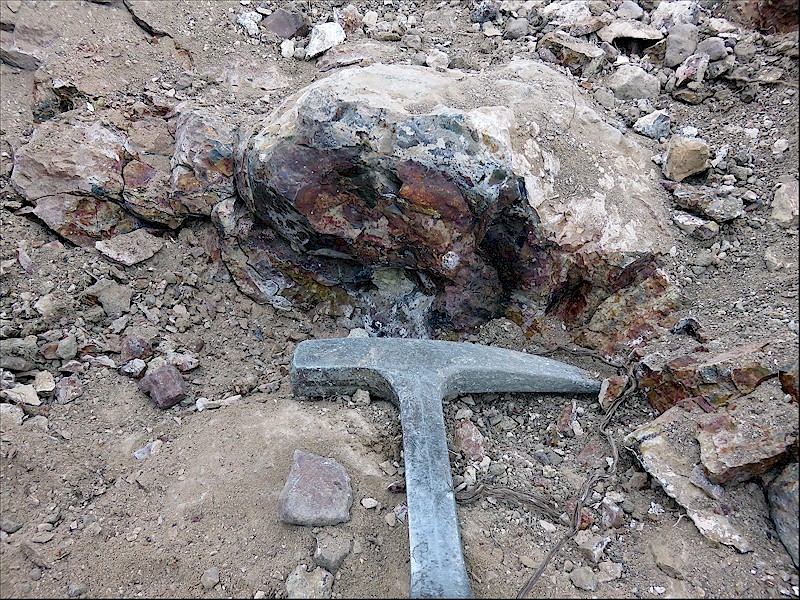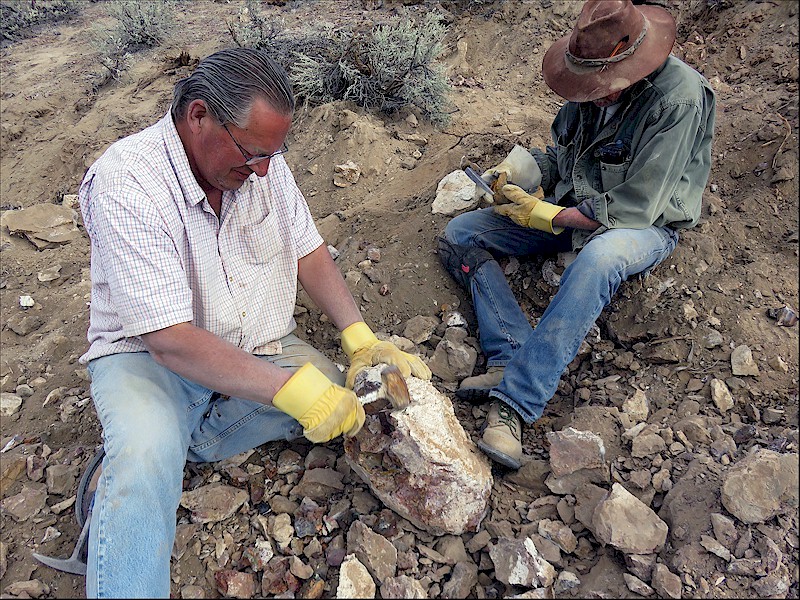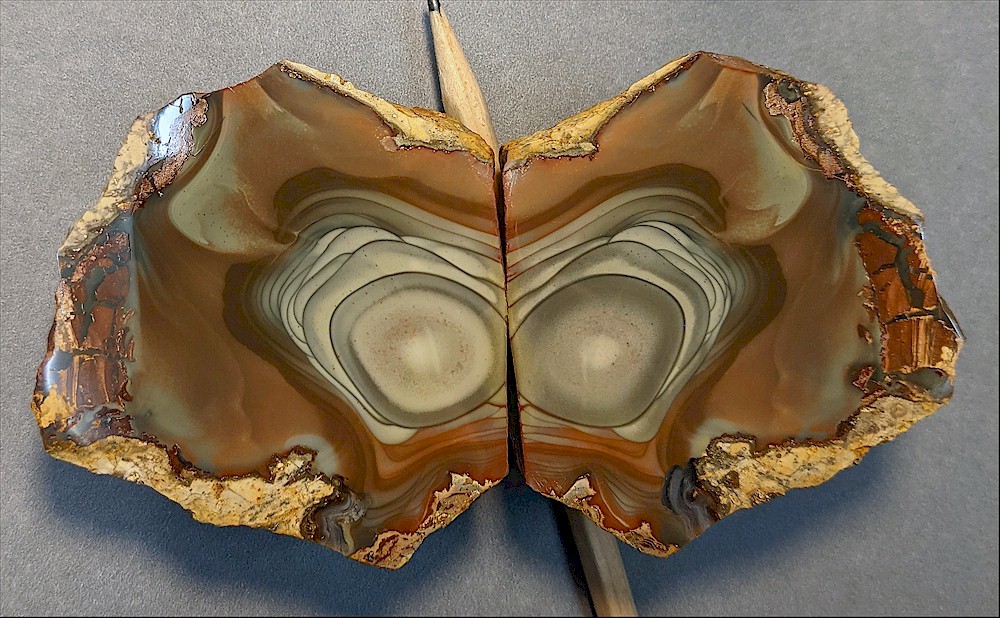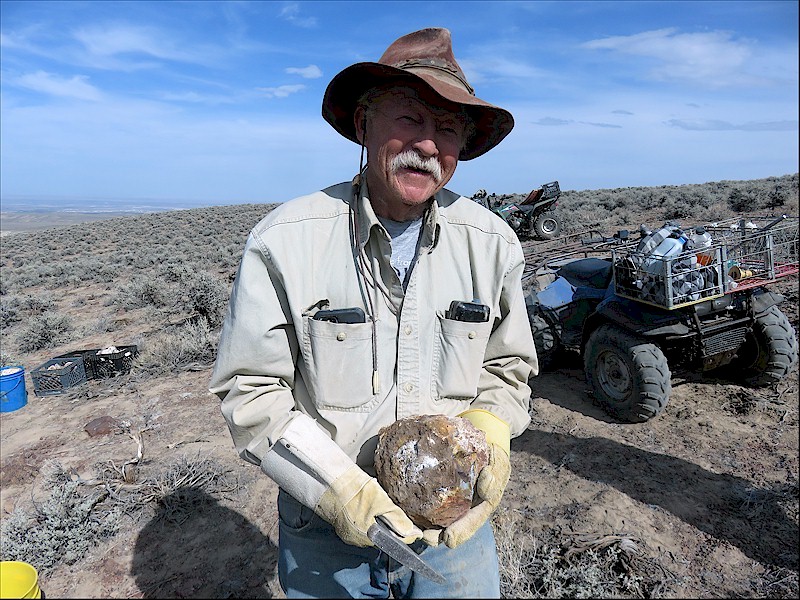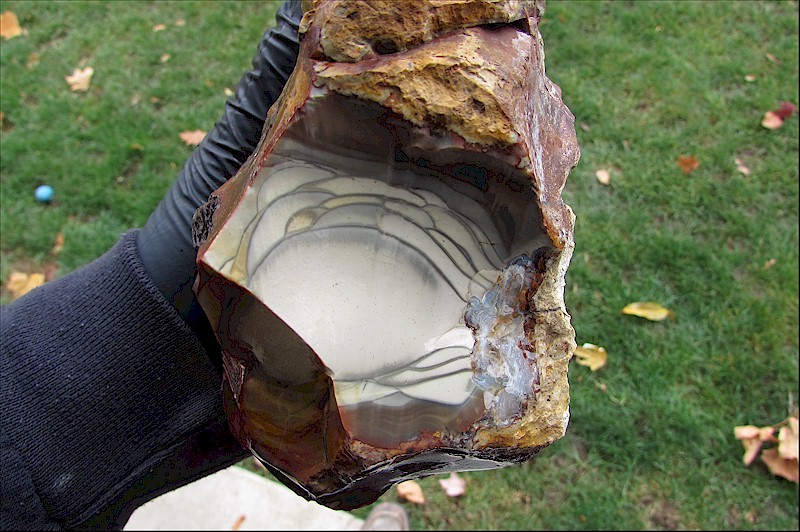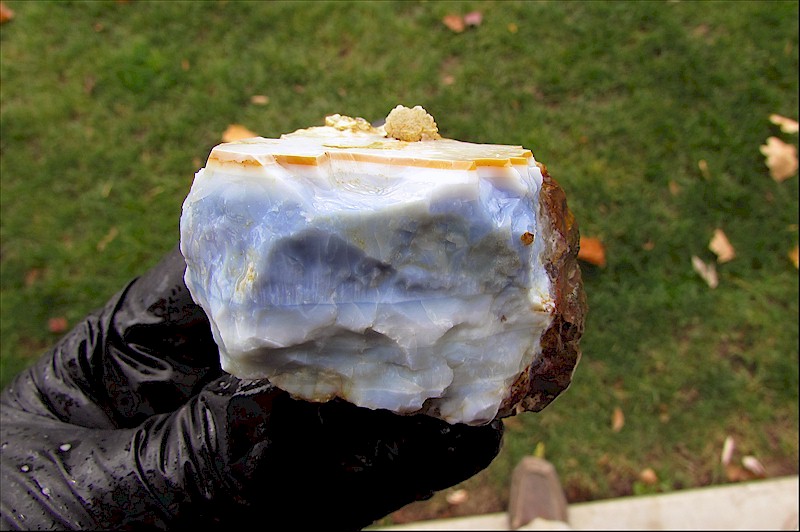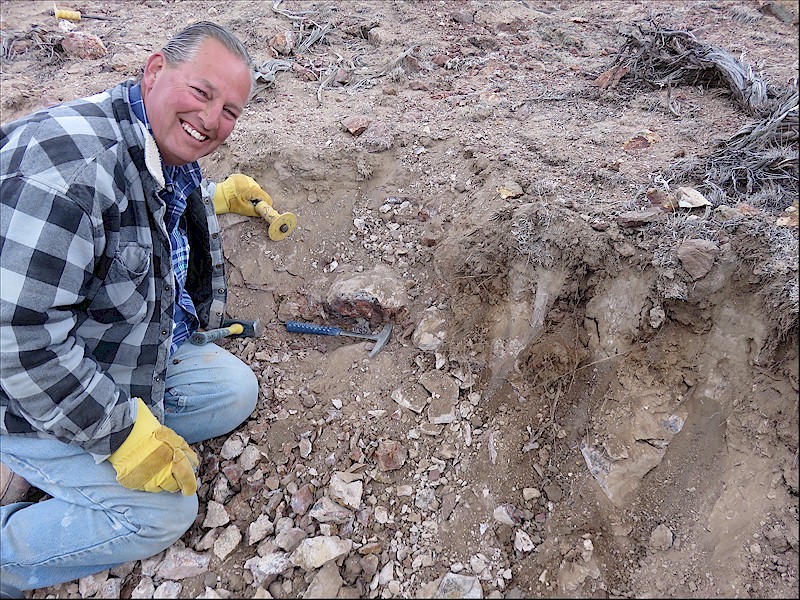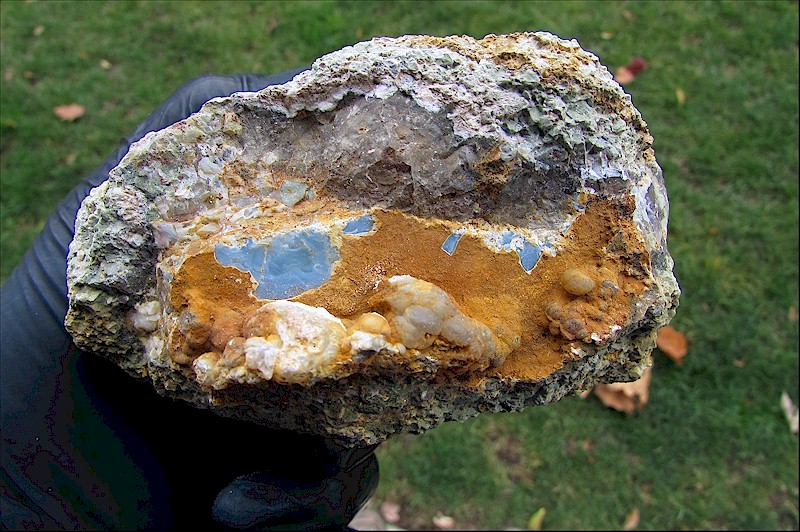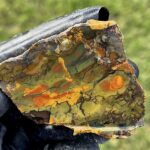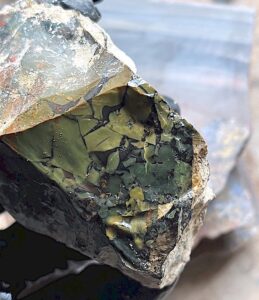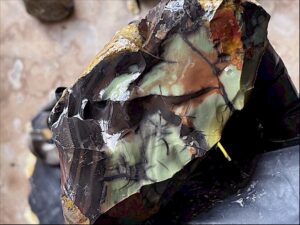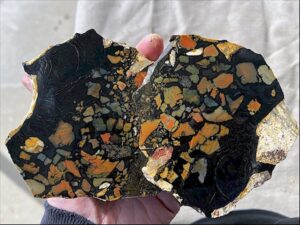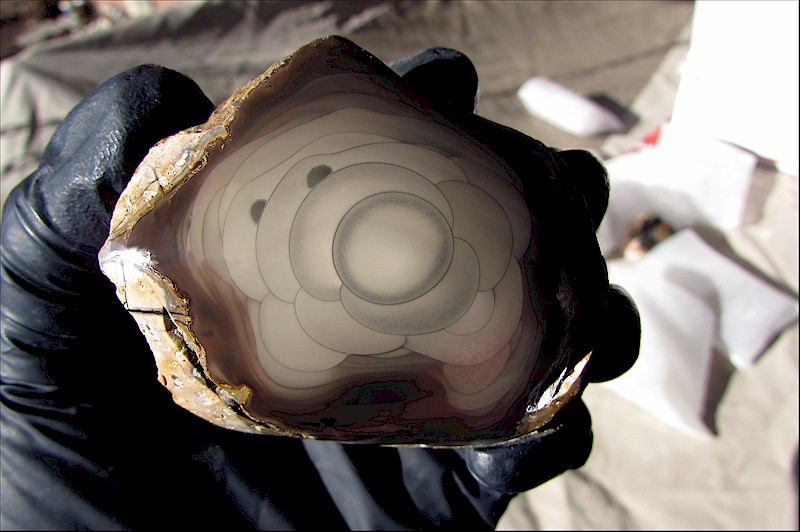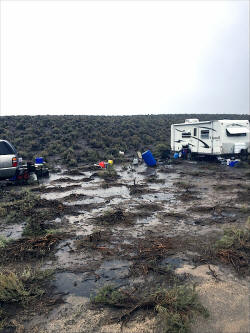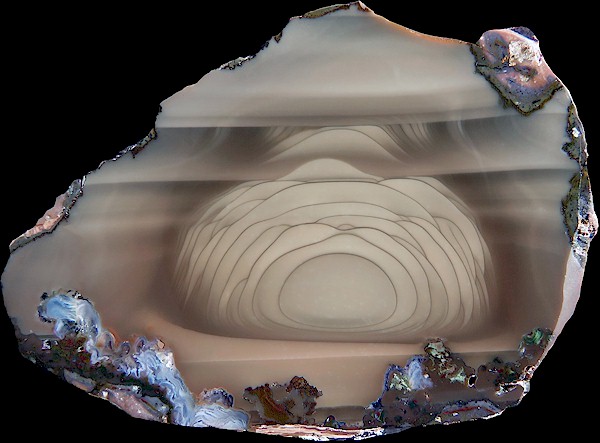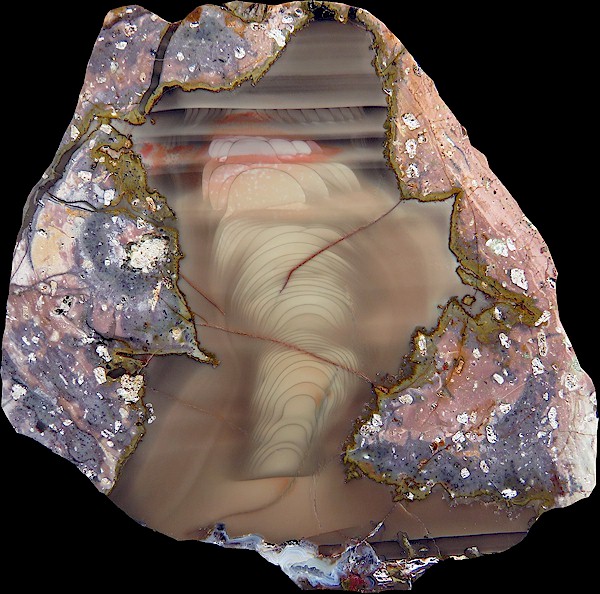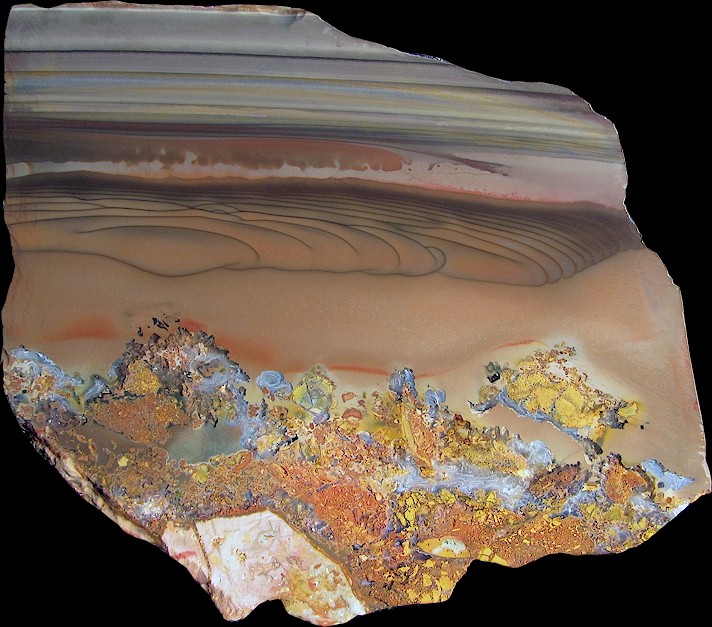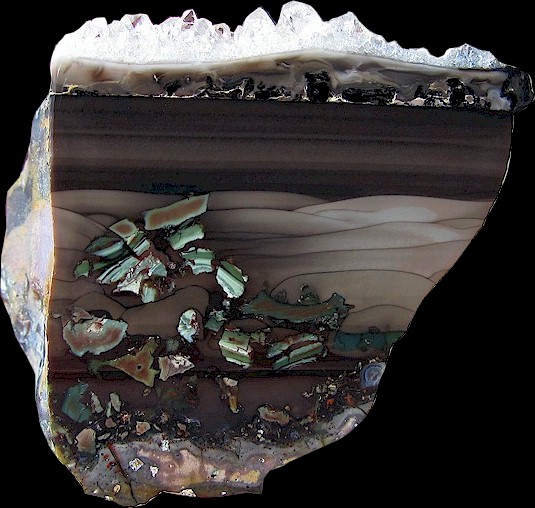
A New Discovery In Idaho
Fall 2016,
I’m on my way over to my good friend, Brian Hendrickson’s, house to look at some rock that he had picked up at an estate sale. He wanted some help identifying it. Brian sells a lot of rock on EBay and was getting ready to upload the pictures for his next sale. I drive up and see he has two buckets of rough. I look it over and see Haystack Butte jasper, which comes from Oregon. He said that he thought so and thanks me. Then he says, “Hey, Scott is home. Let’s go over and see what he’s doing.” “Scott?” I say. “I don’t know him.” Brian says, “Yeah, he lives three doors down and has been a family friend for decades. He used to go out to my Dad’s Big Horn picture jasper claim years ago. He would help my dad dig”. We walk down the street and into Scott’s backyard. I see a good deal of rough rock, in neat piles, in his yard. Brian introduces Scott to me. “You got some neat rock out there”, I say. Scott looks out and says, “Lots of years out there digging.” After a while, Brian looks at me and gives me a sly smile. I know him…something is up. Brian says, “Scott, show Philip that jasper you showed me”. Scott looks puzzled, “The black one?” Brian says, “Yeah, the one you showed me the other day”. Scott walks back into his shop and brings out a softball sized rock. Amazed, I say, “Wow! Now that’s a great, orbed, Black Bruneau!” Brian chuckling states, “That’s not Bruneau”. Confused, I questioned, “Wait…what?”
A Crisp Spring Day,
I get a call from Brian. “Scott is thinking of letting you claim that jasper that he found out in the Owyhee’s and he wants to meet with us again.” It’s been a few years since I initially saw Scott’s jasper. It’s something you try not to think about too much, if you value getting any sleep at night. We meet at Scott’s shop the next day. He asks me if I would like to make a claim on his jasper and all he wants, in return, is a little rock to cut up every so often. Puzzled, I say, “I thought you wanted to mine it?” Scott then relates his rational for asking me to mine it. “After years of keeping the jasper location a secret,” he states, “Maybe it’s time to see what’s in the ground.” Like the rest of us, he’s not getting any younger. Also, he recently came into the possession of a claim of facet, high grade, opal in Idaho that he would like to spend more time with than the jasper. I’m trying not to show too much emotion. Inside, I’m like a little kid at Christmas getting a toy that I always wanted and no one else has. A few weeks later, Scott, Brian and I head out to the area that Scott had discovered. This area of the Owyhee’s is very dry, with big, old sagebrush. Driving over the land with the ATV is going to be hard. I find it amazing, that in order for this sagebrush to grow this big, there must not have been any fires here for a great many years. For this trip, we are going to walk to the area, instead of taking the ATVs. Starting from the dry creek bed, where Scott first saw the initial piece of jasper, we head up the little creek to the flat area where he had found the source. When we arrived at the spot, I look down on the ground. There was very little rock that Scott had left behind. He, basically, vacuumed up the ground through the years of collecting. There are a few proving flakes and tailings in areas, where he had dug small holes. Not much else, in terms of rocks, for us to take home. I could see the host rock was hard Rhyolite similar to Bruneau’s host rock. There were large boulders of it lying on the ground, with pockets of small nodules cemented in to it. This will be quite different from the way I normally dig rough. I may need some advice from miners who have experience in this type of environment. Judging from what I saw on the ground, I may need the advice of Gene Mueller, of The Gem Shop. He lives in Cedarburg, Wisconsin and owns the Regency Rose Plume claim. He also actively digs the Agua Nueva Agate in Mexico, and previously owned the Christine Marie Morrisonite claim. There is also Larry Ridley, who owns the Willow Creek mine, with its large thunder eggs of jasper. As the day progressed, Scott showed us all the places that he thought would be good for prospecting, and for our first dig. I walked around a little more to get a feel for the lay of the land and where I’d be putting up my claim stakes.
Below is the float we found on the first day out with Scott.
Back at home
Fast forward to fall of 2021.
received my Notice approval from the BLM, with very few changes and should be able to begin digging in September. Now, I have to come up with the money to cover the initial costs. I calculated that I will need $10,000, before I even get any rock out. This is unproven ground, unlike my other claims in the Graveyard Point area. This site will be a larger risk. However, the rewards could be great for the rock lapidary and the specimen collector world. Judging from what Scott found on the ground and what Scott had previously hand dug out, this claim has a real potential of being epic. Again, I try not to think too much about it. Otherwise, I will have to resort to drinking a shot or two of whiskey every night, just to get some shut eye.
Digging Day, Fall September 2021.
I thought I would invite Gene Mueller out to help me dig. Maybe, he would enjoy getting away from the shop for a while and helping me make the discovery of this new claim. Since he had offered so much advice and insights into this expedition, I thought it would be a good way of saying, “Thanks.” I knew The Gem Shop was always such a busy place and I hoped he could find the time. As it worked out, he did have a time frame that he could come out. Between him and Brian Hendrickson coming out to help, I knew this was going to be a great time.
After walking the excavator the four miles in, we arrived at the site. We started prospecting with the aid of the excavator. Prospecting with the excavator is like using a garden hoe, but magnified exponentially. The process involves scraping off a little of the ground area, stopping, walking over to the exposed area and looking to see if anything has, “Popped up.” Repeating this process, over and over in the course of each day can be a very tedious process. In the beginning, we find nothing worthwhile. I’m getting a little worried. I stop digging, turn off the machine and just sit there contemplating. Brian and Gene are on the ground spotting. They look up wondering why I had stopped. Brian has been with me, at all my claims, and knows me well. Gene is about to say something. Brian holds up his hand, says something to Brian and Gene stops. After a while, Brian walks slowly up to the excavator and says, “What you think’n Boss?” Then, Gene walks up. Together, we discuss this spot and all agree that the good stuff we are finding is just float from somewhere else up hill. I point to the side of the hill from where we are currently digging. I say to Brian, “Remember when Scott took us up here and we found that exposed boulder over there with the black nodules with orbs imbedded in it?” Gene and Brian look over to where I’m pointing. “Let’s walk over there and take a look on the ground”
The Black Pit.
We started digging out and around the boulder. Instantly, small nodules come to the surface. The boulder was part of a much larger deposit, full of black nodules. Jackpot! Picking up and then proving out the nodules with a small tap of the hammer revealed beautifully orbed and colorful, brecciated patterns together. These patterns of orbs and brecciate together is truly unique. Neither Gene nor I have ever seen it in combination anywhere else. We pulled out varied sizes from large marble to baseball sized nodules. The most exciting ones were the orbed nodules. Some were very similar to the Bruneau nodules in some ways, but different in many other ways. Two main difference was COLORS! and orbs with brecciate or just brecciate. There were Red, yellow, tan and green orbs with brecciate mixed in the orbs!…WOW!
As I dig, I find many more nodules, further down. Finally, I reach the base rhyolite host rock floor which happens to be loaded with thousands of black nodules cemented in it. This base rock is practically impenetrable with the excavator teeth, which are now worn and rounded by use. I put on some fresh sharp teeth ($100 each) on the excavator bucket and it seems to help. We spend about three days at this particular spot, which I name, The Black Pit. I only have a limited amount of time to focus on this particular spot. I don’t have the luxury of extra time to work through all the base rock and so I decide to save the harder extractions for the next time. For now, I make the decision to get the easier extractions and move on. I have other good prospects to explore still and I need to see what else can be discovered in the area.
Scott's Hole
The nodules at Scott’s Hole are a little different from the Black Pit. They are larger and have different variations of colors; green, red, black and even some with the traditional Bruneau cinnamon. In addition to nodules, we pull up large blobs of beautiful brecciate. Not really a nodule or a vein, they are more like an intersection in the rhyolite. As time passes, the pit is getting wider and deeper. Most times the excavator is sitting idle, as we prospect and hand dig the outer edges of the pit. The excavator’s main function is not necessarily digging the nodules or veins out. Its main function is moving the muck. One quick, big scoop of waste dirt or tailings is worth a half a day of hand digging it out, let alone the wear and tear on one’s body.
It’s getting late and I decide to take a break. Sitting on my ATV, I eat lunch and watch as Gene and Brian continue to dig. Sitting somewhat away from them, I see Brian call Gene over to where he’s digging. They are now kneeling down, with their backs to me, looking into a small hole along the pits’ edge that Brian had dug. Brian takes out his chisel and hits it a few times. He stands up and looks over at me with the rock hiding behind his back leg and, as he smiles. I say with a plain voice, “Find something over there?”, as I stuff another potato chip in my mouth. Gene looks over his shoulder and chuckles. Brian walks across the pit to me, with the rock hidden. He stops in front of me, saying nothing, smiles and waits. “Well, are you going to show me what the hell you found or what?”, I say laughing. He pulls it out from behind his back and hands it to me. It is a large grapefruit- sized nodule, 6” across, and nearly perfectly round. I reach out to take it and he quickly pulls it back and says, “No way…this one’s mine!” I say, “What the hell!” Already in my mind, I see he’s awfully proud of what he has found and I’ve already decided to let him have it. I can’t help but have fun with him saying, “I own the mine, you keep the big one and I get the small one? What the hell kind of logic is that?” We banter back and forth some more. Finally I say, “At least, let me hold the damn thing!” He reluctantly hands it to me. Man, is it heavy. It must be solid jasper inside. One side has already been chipped off showing big orbs. Turning it around in my hand and looking at it, I can’t help myself, but to have one more dig at Brian. I place it in the wired basket on my ATV, right on top of the other smaller nodules. “No way in Hell!” he says, grabbing it from the basket. Laughing hard, I give in and say, “Ok, you can have this one, but I want the next one.” Brian chuckles stating, “Gene already has that one.” Shocked I get off the ATV and walk over to where Gene is digging. Sure enough, there’s another one about the same size. I have Gene hold it up, as I take a great picture of the smiling, proud, new owner.
It’s been over a week now and the two pits have been fairly productive for the claim’s first dig. Fortunately, I don’t have to dig very big holes to find good rock and in that respect, the closing of the pits shouldn’t take too long. The nodules come in various sizes, ranging from marble to soccer ball. The biggest ones tend, for now, to be fractured in halves or thirds. I think, because of them being closer to the surface, water and temperate variances of expansion and contraction have occurred. Even so, the jasper in the nodules is still high quality, dense, and has no spidery fractures. I think the rhyolite covering protects them, in this respect. The rhyolite is fairly “sticky”, stubbornly adhering to the nodules, making it more difficult to clean. In some cases, when I plan on slabbing the nodule, I let most of the rhyolite stay on. In this way, rather than trying to clamp onto a round rock, it’s easier for the slab saw to clamp and hang onto something. The other type of formation that I found a great deal of here is a vein/blob formation which was always brecciated. The most beautiful of the ones I dug out were the ones with a black background and had colorful brecciate of green, red and yellow. This type is more of a slabbing/cabbing material for cabochons than of specimens
Nodules with Brecciate
"we need to get the Hell out of here!"
I’m on my way over to my good friend, Brian Hendrickson’s, house to look at some rock that he had picked up at an estate sale. He wanted some help identifying it. Brian sells a lot of rock on EBay and was getting ready to upload the pictures for his next sale. I drive up and see he has two buckets of rough. I look it over and see Haystack Butte jasper, which comes from Oregon. He said that he thought so and thanks me. Then he says, “Hey, Scott is home. Let’s go over and see what he’s doing.” “Scott?” I say. “I don’t know him.” Brian says, “Yeah, he lives three doors down and has been a family friend for decades. He used to go out to my Dad’s Big Horn picture jasper claim years ago. He would help my dad dig”. We walk down the street and into Scott’s backyard. I see a good deal of rough rock, in neat piles, in his yard. Brian introduces Scott to me. “You got some neat rock out there”, I say. Scott looks out and says, “Lots of years out there digging.” After a while, Brian looks at me and gives me a sly smile. I know him…something is up. Brian says, “Scott, show Philip that jasper you showed me”. Scott looks puzzled, “The black one?” Brian says, “Yeah, the one you showed me the other day”. Scott walks back into his shop and brings out a softball sized rock. Amazed, I say, “Wow! Now that’s a great, orbed, Black Bruneau!” Brian chuckling states, “That’s not Bruneau”. Confused, I questioned, “Wait…what?”
I’m very grateful for Gene and Brian’s help in making this a successful dig. I am thankful for Gene’s vast experience, knowledge and advice and Brian for his way of keeping me centered and committed, along with his badger-like digging that never ceases to impress me. Finally, I thank Scott, whose trust in me to awaken his dream of bringing Whiskey Creek to the world.
Cheers!
Philip-
